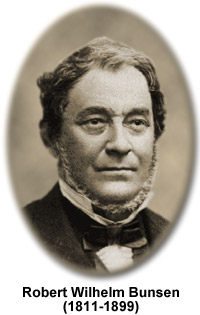Robert Wilhelm Bunsen
(1811-1899)

Robert Bunsen is most familiar today in association with the Bunsen burner, a device found in educational chemistry laboratories around the word. Ironically, Bunsen only made minor alterations to the familiar burner, rather than inventing it, and made many more generally important contributions to science. Indeed, in work he carried out with Gustav Kirchhoff, Bunsen helped lay the foundations of spectroscopy, a field that has had a tremendous impact on the modern understanding of the world.
Bunsen was born in Göttingen, Germany on March 31, 1811 and was raised in an environment conducive to learning, his father being a professor of modern languages at the university there. Before he was twenty years old, Bunsen had obtained his doctorate in chemistry at Göttingen University. He spent several years following this achievement traveling through Western Europe. Upon his return, Bunsen taught at several different universities, including institutions in Marburg and Breslau, before settling at Heidelberg, where he taught from 1852 until his retirement, and established an exceptional chemistry department. There he was habitually absorbed by his experiments and analyses, never finding the time nor the inclination to marry.
In 1834, Bunsen discovered that hydrated ferric oxide was an antidote to arsenic poisoning, a finding that was personally significant to him since he nearly died of arsenic poisoning several years later while carrying out studies of cacodyl, an arsenical oil. During his investigations of the toxic compound he also became blinded in one eye from an explosion in the laboratory. These setbacks led him to ultimately abandon organic chemistry research. He was extremely inventive, however, and found many other topics to occupy his time. In 1857, he published Gasometrische Methoden, a work that detailed his methods for obtaining volume measurements of gases, and later developed several new devices, including the filter pump (1868), a sensitive ice calorimeter (1870), and the vapor calorimeter (1887). He also was the inventor of what has come to be known as the Bunsen cell (a carbon-zinc electric cell) and the grease-spot photometer, which he developed in order to quantify the amount of light produced by the cell.
Bunsen’s investigations with magnesium, which he was the first to obtain in the pure metallic state and to find that it was a brilliant illuminating agent, reportedly influenced his interest in the relationship between light and chemicals, and Bunsen became a pioneer of photochemistry. In this field, he collaborated with Sir Henry Roscoe for nearly a decade, the pair primarily concentrating on the formation of hydrogen chloride from gaseous hydrogen and chlorine, which is specifically related to the amount of light present. In the late 1850s, Bunsen suddenly broke off his work with Roscoe due to a new collaborative effort with the physicist Gustav Kirchhoff, whom he had become acquainted with in 1851 and had arranged to be given an appointment at Heidelberg University. The momentous nature of Kirchhoff’s discovery that similarly colored flames could be distinguished from one another by utilizing a prism to divide the light into its constituent rays and that all pure substances have their own characteristic spectra appears to have led to Bunsen’s decision. He subsequently dedicated his laboratory to the nascent field of analytical spectroscopy (the study of the emission and absorption of light and other radiation by matter in terms of their relationship to the wavelength of the radiation).
During their spectroscopic investigations, Bunsen and Kirchhoff discovered cesium and rubidium, and more importantly, made it possible for a more detailed understanding of the composition of the sun, stars, and other celestial bodies to be obtained. It was also in the course of these studies that Bunsen redesigned the burner in his laboratory, which has become the well-known Bunsen burner. The improved device allowed for more ready control over the heat of the flame obtained. Bunsen and Kirchhoff’s research was further aided by their development of the spectroscope, which continues to be a vital optical instrument even today.
Bunsen’s illustrious career made him highly esteemed by his students and colleagues, and he received many honors. He was elected into the Chemical Society of London (1842), the French Academy of Sciences (1853), and the Royal Society of London (1858). The latter association bestowed him with the Copley Medal in 1860, and in 1877 Bunsen and Kirchhoff became the recipients of the very first Davy Medal. In 1898, the year before he died, Bunsen was awarded the prestigious Albert Medal by the Royal Society for the Encouragement of Arts. Despite his numerous tributes, Bunsen maintained a reputation for modesty and even once characteristically claimed of his awards that, “Such things had value for me only because they pleased my mother; she is now dead.”
